Senior Citizen is defined as any person aged sixty (60) years or over. (Source: Republic Act 9994, Section 3.A). Globally, older persons refer to those aged 60 years or over.
69 males per 100 females is recorded sex ratio among senior citizens
The household population of senior citizens in the city was 10,256 or 8.46 percent to the total household population. From this number, 4,184 or 40.80 percent were males; and 6,072 or 59.20 were females resulting to a sex ratio of 69 males per 100 females.
Figure 1 shows the age-sex population highlighting the portion of senior citizens in the City of San Juan as of the last census in 2015. Age-group 80 years old and over recorded a total share of 12.31 percent to the population of senior citizens where females outnumbered males. The figure also depicts that females tend to live longer than males.
More than half of the population of senior citizens are still married
More than half of the population of senior citizens or 55.97 percent (5,740) were still in compact of marriage; while 27.32 percent (2,802) were already widowed. Eleven percent of their population were single or those who were ever since unmarried. Figure 2 shows the percent distribution of senior citizens in the city by their marital status.
99.78 percent of the senior citizens are literate
A total of 10,233 or 99.78 percent of the population of senior citizens were literate or those who can read and write simple messages. The literacy rate among male senior citizens was recorded at 99.78; while, 99.77 was recorded among female citizens. Only 23 or 0.22 percent were recorded illiterates.
Most of the senior citizens are college degree holders
Among the senior citizens, 34.85 percent or 3,574 were college degree holders. Almost one-third, 31.17 percent (3,197), of them were graduate of high school or attained high school level. Meanwhile, 0.31 percent (32) senior citizens were recorded of no grade completion or those who have not attained at least basic level of education.
More than half of the senior citizens are declared as household head
The head of the household is an adult person, male or female, who is responsible for the organization and care of the household, or who is regarded as such by the members of the household. A total of 5,904 or 57.57 percent of the senior citizens were declared or regarded as household head. Among the household heads, 3,417 (57.88%) of them were males, while 2,487 (42.12%) were females.
164 senior citizens are regarded as domestic helpers
The Labor Code of the Philippines defines “domestic or household service” as a "service in the employer's home" that provides convenience and personal comfort to the employer. Domestic helpers include maids, cooks, yayas (nannies), drivers and all-around helpers. Based on the results of 2015 Census of Population (PopCen), in the City of San Juan, there were 164 senior citizens (1.60%) were regarded as domestic helpers in a household.
1.14 percent of senior citizens are overseas Filipino workers
A total of 117 senior citizens (1.14%) were overseas Filipino workers. A household member who is an overseas worker is one who is currently out of the country due to overseas employment. He/she may or may not have a specific work contract or may be presently at home on vacation but has an existing overseas employment to return to.
One out of four senior citizens were managers; more male managers than females
More than one-fourth or 942 of the senior citizens to total gainful workers of 3,269 in the city were working as managers. This was followed by the service and sales workers with 13.95 percent or a total of 456. The figure 4 shows the gender gap based on major classification of occupations senior citizens have. The graph shows that the longer the line, the bigger the gap with respect to number of senior citizens by occupations. Moreover, it also revealed that most women were in elementary occupations and service and sales workers and the gap of number of male and female senior citizen professionals was minimal. Meanwhile, on the occupations which need physical strength like plant and machine operators, male still dominate.
94.95 percent of senior citizens have ever had a copy of their birth certificate
From the results of 2015 PopCen, a total of 9,738 or 94.95 percent of senior citizens has ever had a copy of their birth certificate. While, 3.57 percent or 366 has never had a copy of their birth certificate; and 1.48 percent or 152 answered don’t know or not reported. This means that some senior citizens have never seen or handled a copy of their birth certificate. The purpose of collecting these data is to determine the extent of birth registration in the country. Low registration of births would prompt policy makers and program managers to devise measures to increase the level of birth registration.
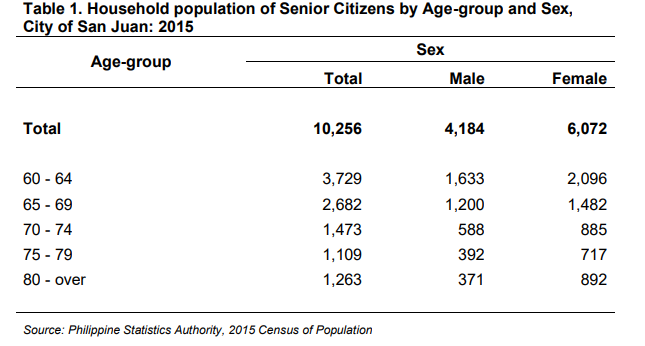
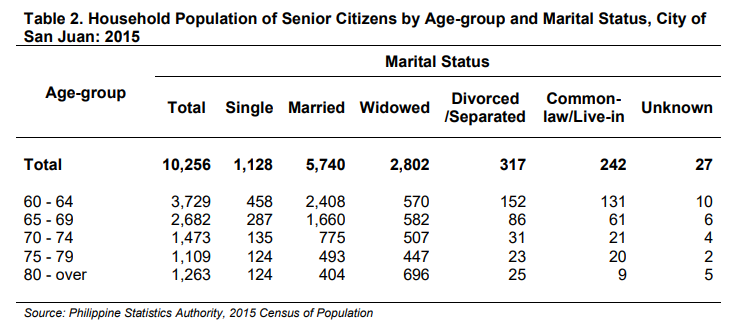




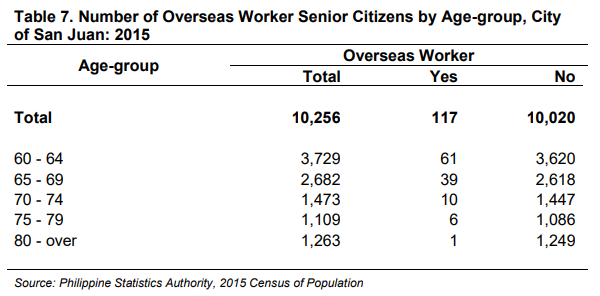
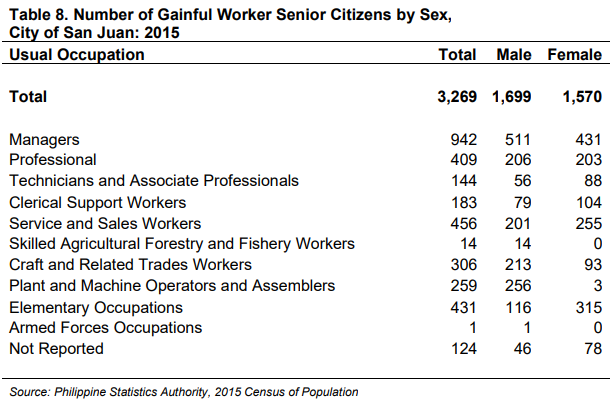
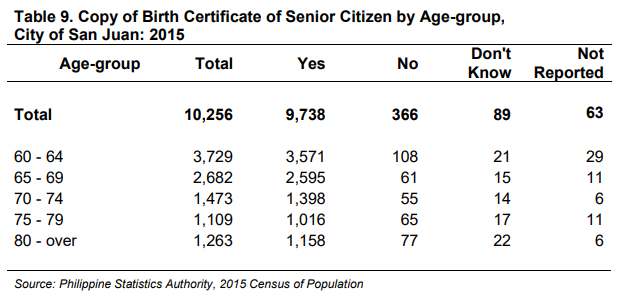
(SGD.) Danilo R. Cubinar
Chief Statistical Specialist
